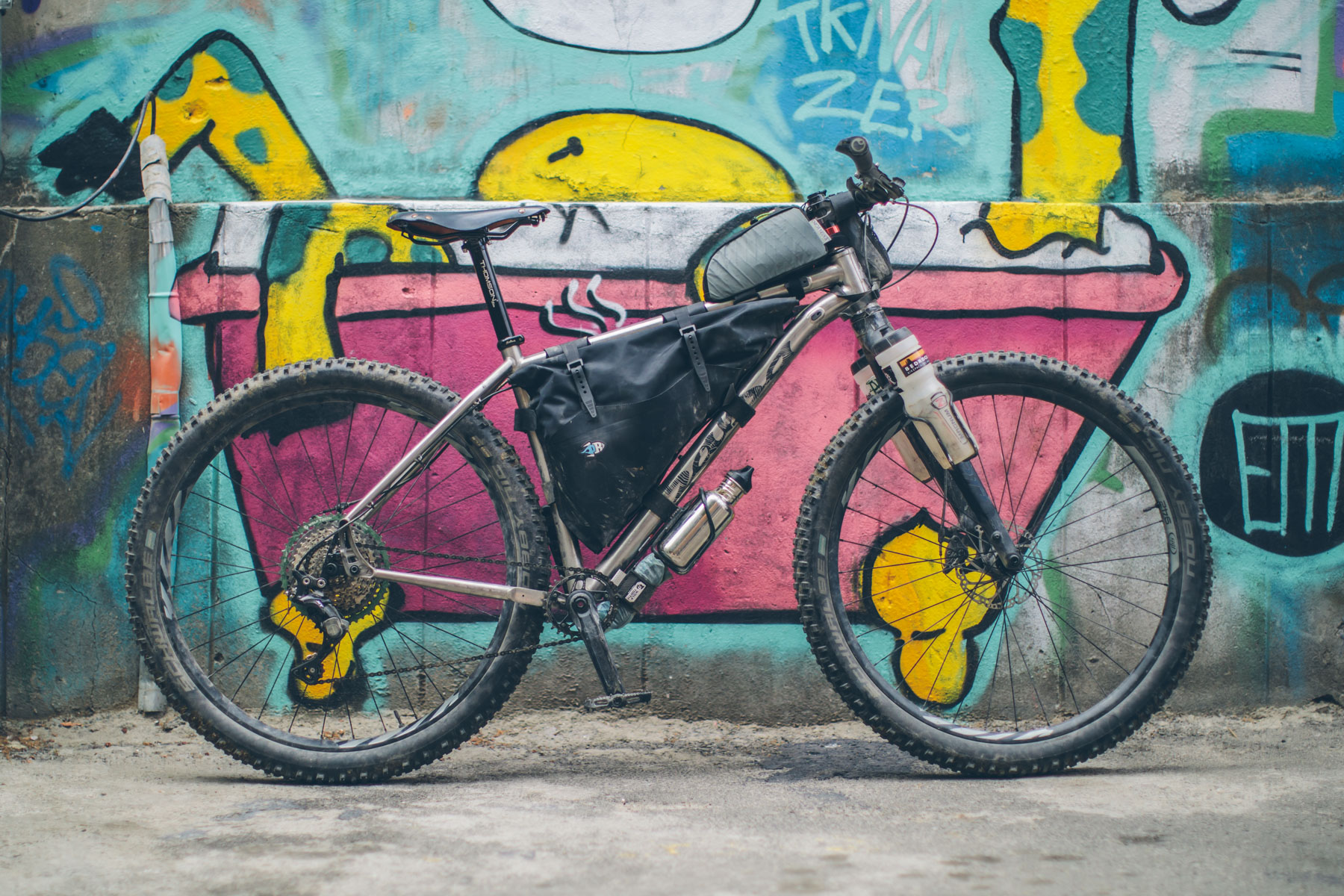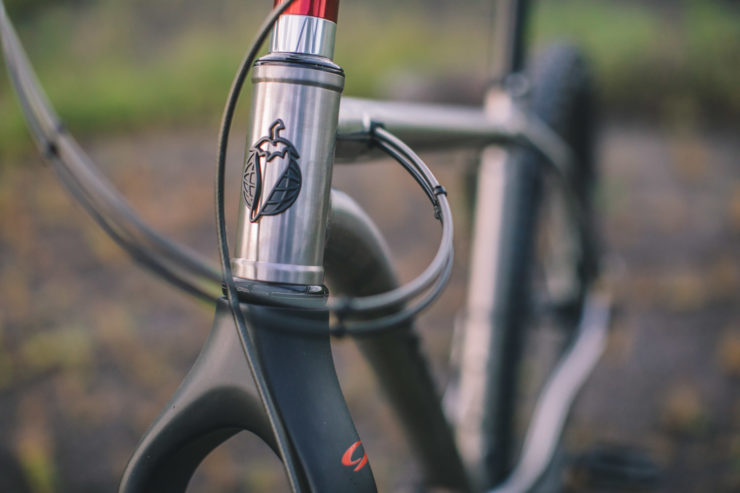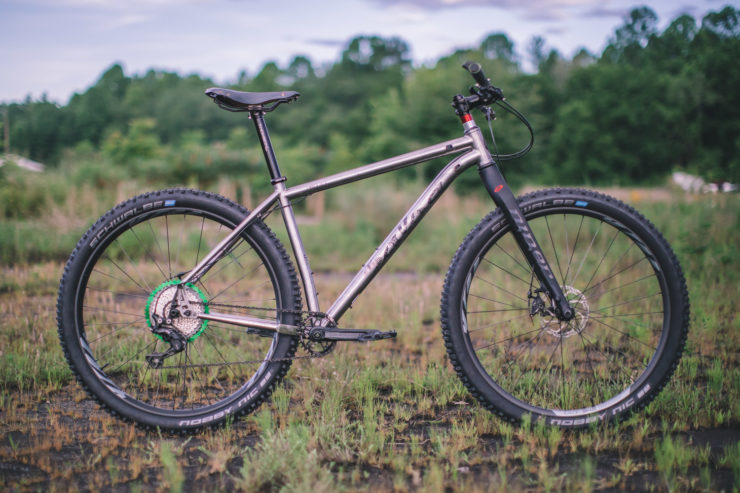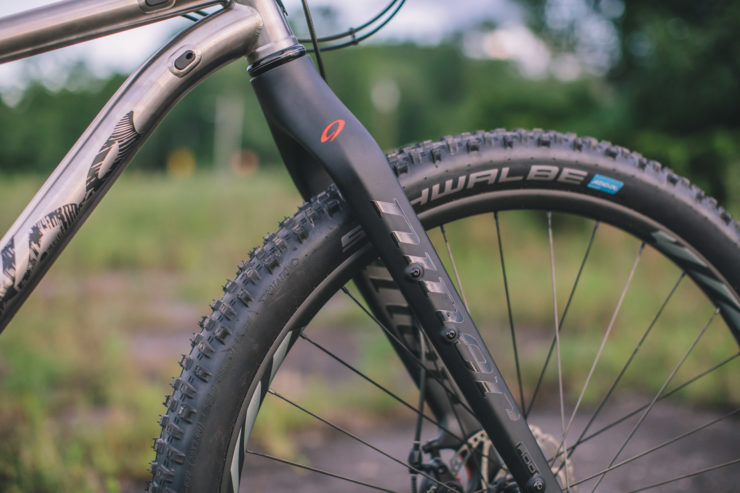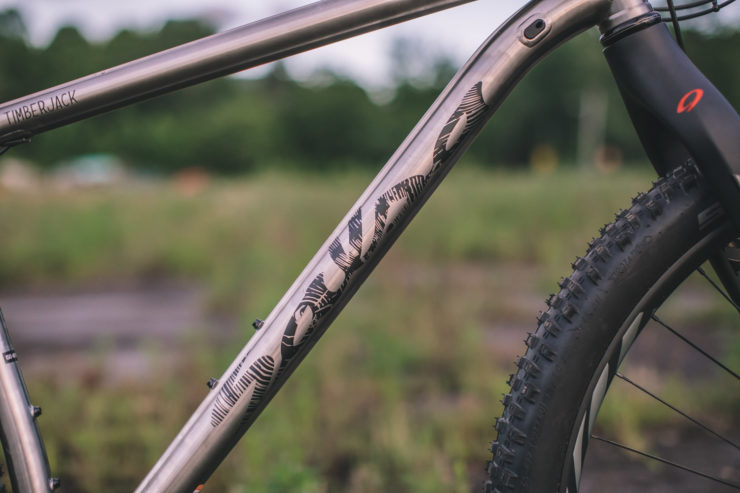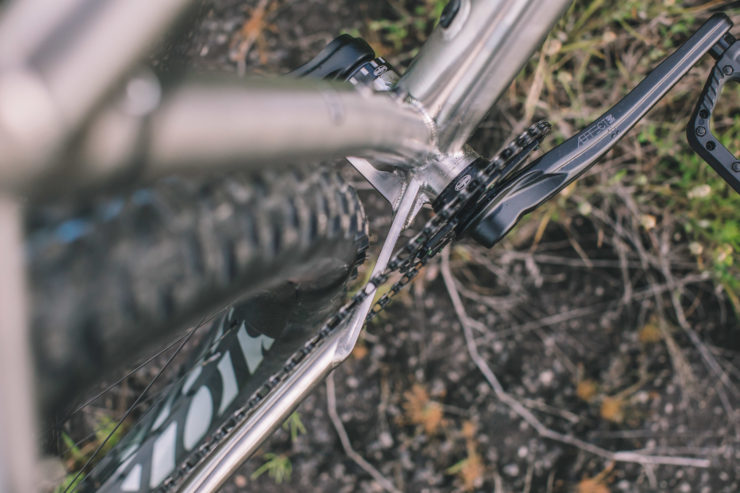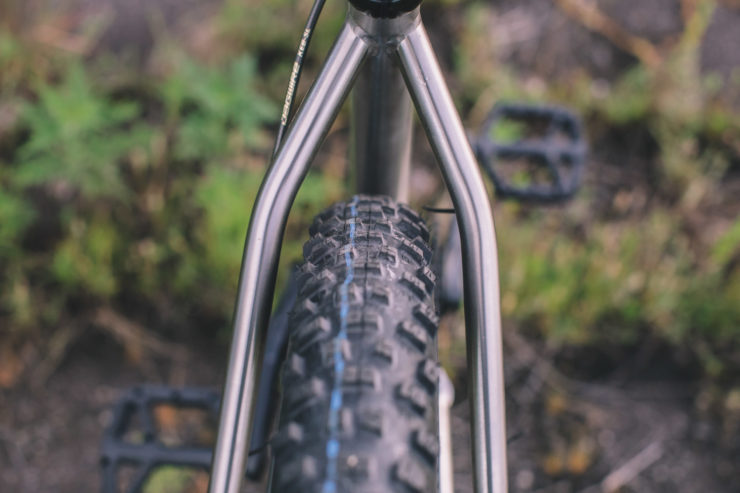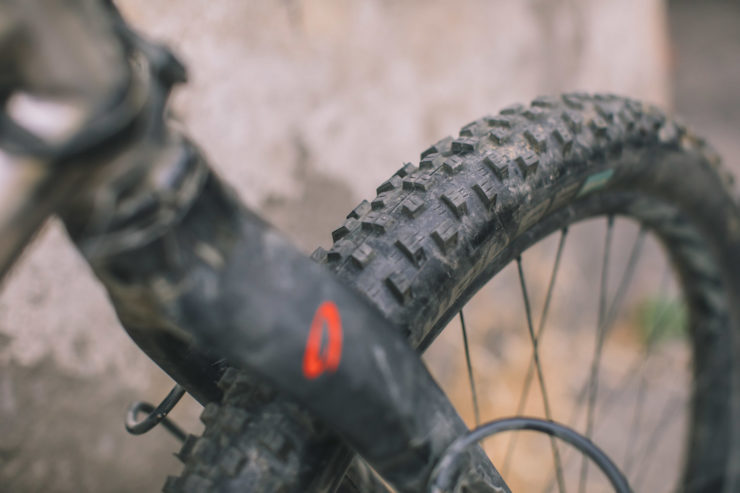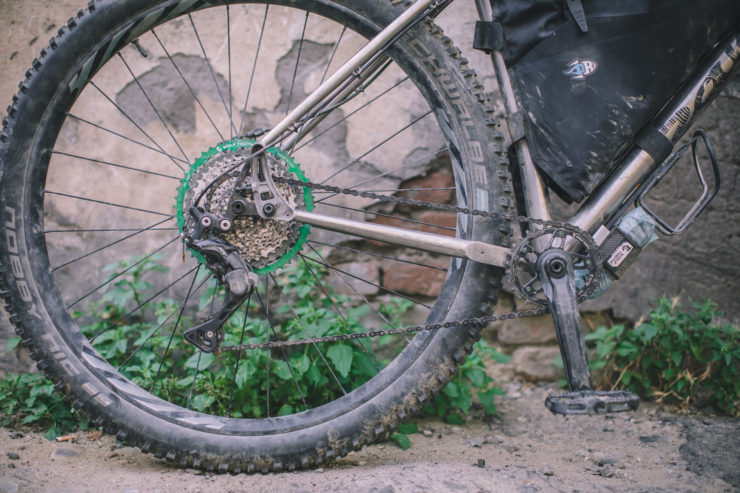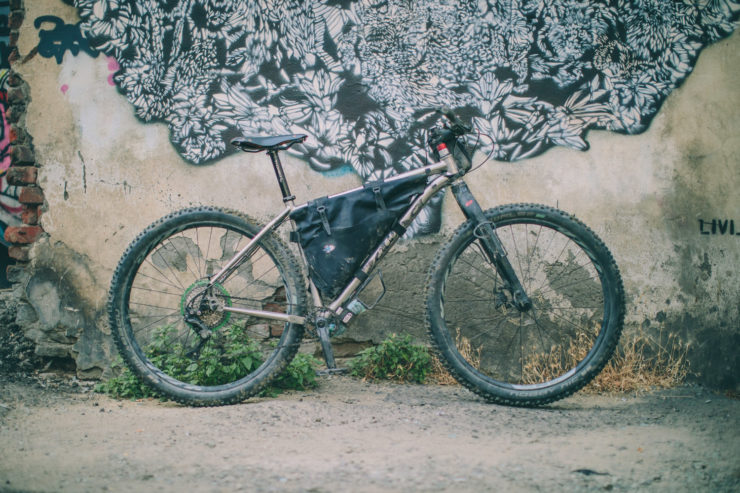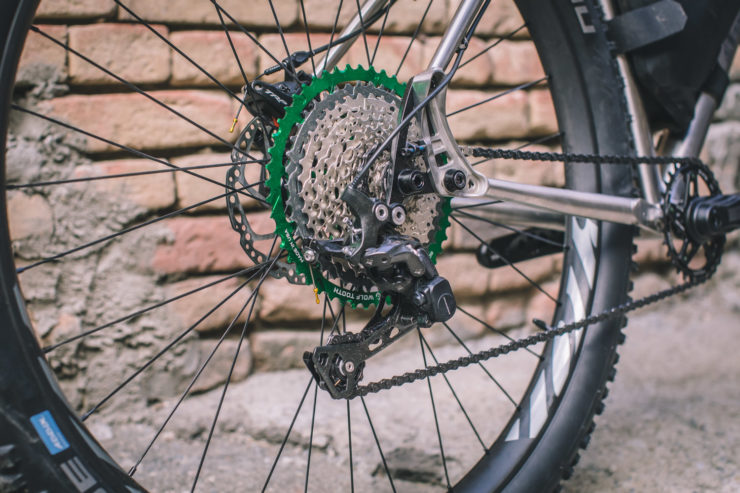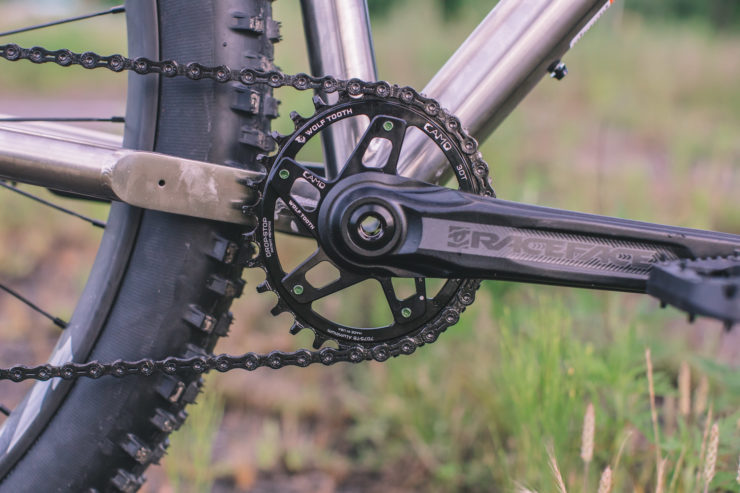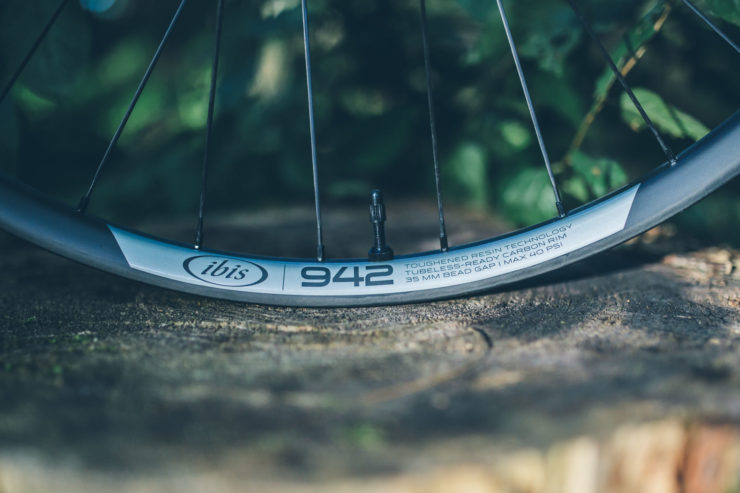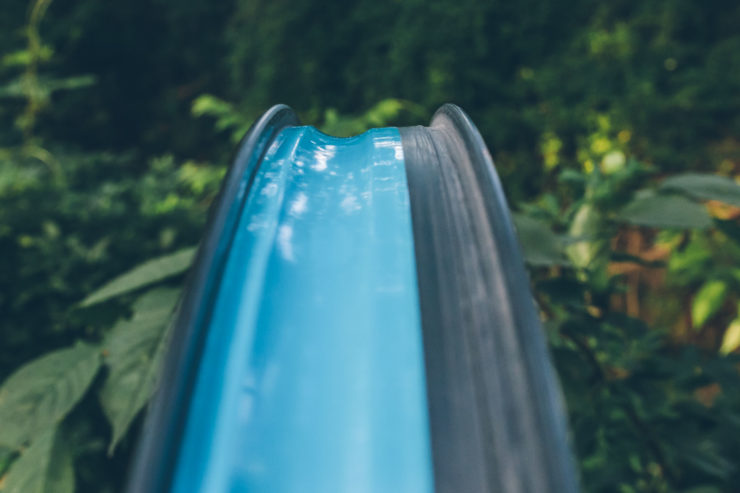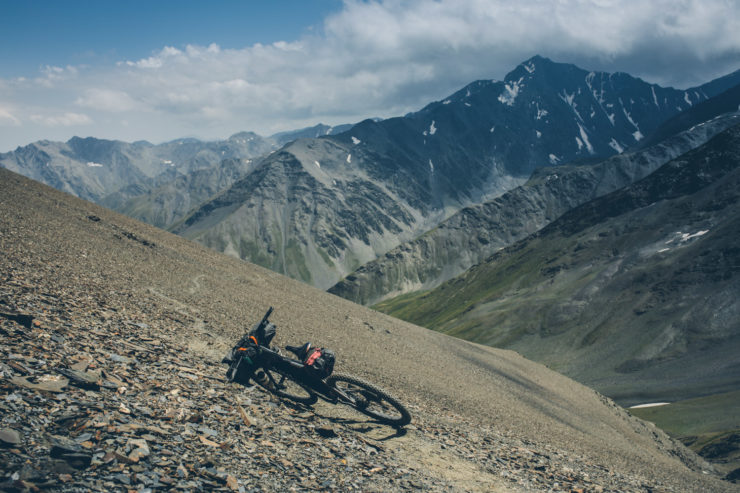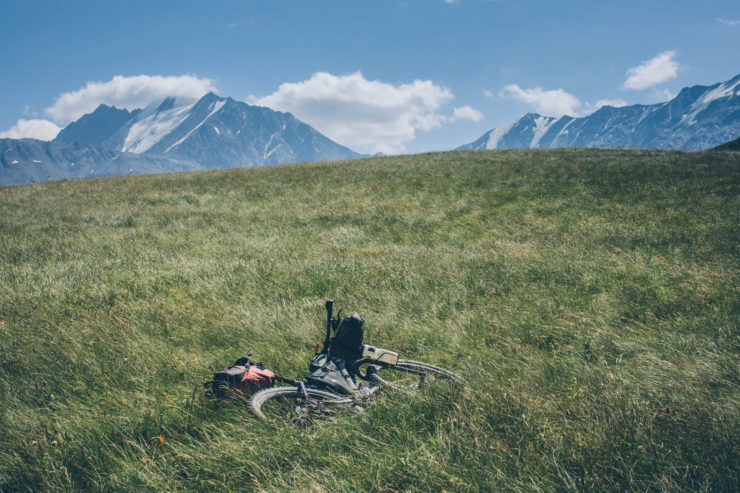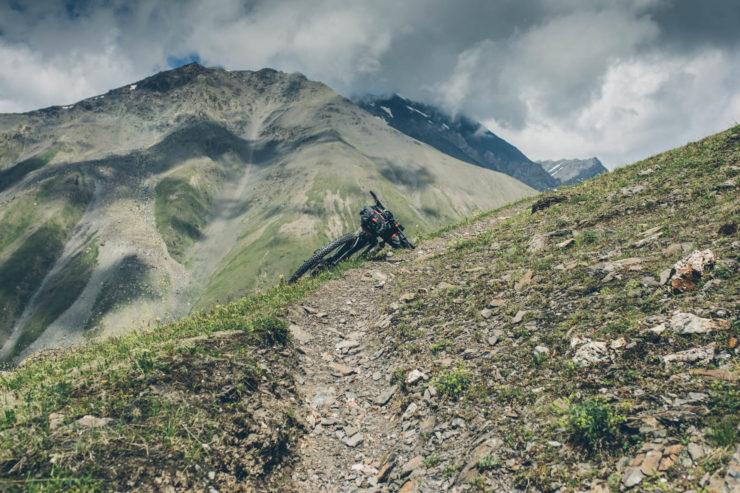Logan’s Salsa Timberjack Ti: Space Metal Dream Build
Share This
With a Niner carbon fork and Ibis hoops, Logan dialed in his Salsa Timberjack Ti for ultralight adventure. Read why he picked this frame and a cast of components that includes a Shimano/Wolf Tooth wide-range 1x drivetrain, I9 hubs, and 29×2.6″ rubber for his dream bikepacking build…
Last spring, I pulled the trigger on a new bike. Prior to that decisive moment, I wasn’t quite ready to commit to a new bikepacking rig. I had sold my ECR, but I was regularly demoing new bikes for review, so I had the luxury of waiting. Honestly, I kind of felt like the ideal frame didn’t yet exist. And as much as I love the idea, I wasn’t fully prepared to commit to a custom bike by an independent framebuilder, either. After all, mountain bike hub standards and frame geometry have been shifting about as much as my own wants and requirements. But that all changed when Salsa announced the Timberjack Ti, which is—as far as commercially available framesets go—the closest thing to the bike I would have had custom built.
Timberjack [Ti]
So what made the Timberjack Ti frame so special? First off, space metal. I’ve never owned a Ti bike before, but I have ridden a few. And I was intrigued. Titanium is a lightweight, corrosion resistant, and scuff-proof material with an unmatched strength to weight ratio. What could be better for a frame to support the optimal “Adventure by Bike” build?
And, why are there so few titanium options on the market, especially amongst mainstream bike companies? According to Justin Julian, Salsa’s Brand Manager, “The major death blow to Ti was the invention of carbon fiber bikes. Nowadays the demand for titanium bikes is small and testing costs are far more expensive than steel or carbon.” In a nutshell, while cost of manufacturing and producing carbon frames has decreased over the past decade, the same can’t be said for titanium frames. In comparison, those expenses have remained relatively steady. Carbon is also much easier to mold than titanium. This allows companies that are working with carbon to put their own spin into unique shapes, tube profiles, and suspension configurations. Whichever the reasons, margins or looks, it seems that titanium framesets have gone out of favor with a lot of bike companies. Even Salsa, who was a late devotee to titanium, pulled its Ti frame options out of its 2016 model year lineup. This agitated a few diehards, but thankfully Salsa released titanium versions of their popular Fargo and Timberjack frames… just in the nick of time.
All told, as I mentioned in the Niner RDO fork review, I was keen on my next bike being extremely light, fast, stiff, and responsive. Titanium speaks all those languages exceedingly well.
“Trail-Touring” Geometry Musings
As I try different bikes, my geometry journey—and my understanding in how it impacts ride quality, and what works best for me—has evolved. The Timberjack has a geometry that’s dialed toward what I’d call comfortable trail bike. When I first demoed the aluminum model in 2016, I found it to be both spritely on the trails and comfortable to pedal—a sweet spot as far as a bikepacking bike is concerned. While I usually prefer singletrack-heavy routes, much of what I ride falls in the dirt road category. In either situation I favor a long geometry that leans toward the trail bike side of the spectrum. Case in point, with both the Surly Krampus and ECR at my disposal, I chose to ride the Krampus the majority of the time.
There are a few specific aspects of the Timberjack geometry that work particularly well for me, the most notable being its steep seat tube angle. That angle, paired with a long reach, places the rider’s weight over the middle of the bike while climbing. This seems more beneficial when it comes to taller riders. This neutral positioning also allows for a fluid transition to a downhill stance. You’re further back when you stand up on the pedals to descend, which keeps a good center of gravity for braking and maneuvering at higher speeds. As Skyler pointed out in his Kona Big Honzo review, and as Benedict hinted at when mentioning the geometry inspiration behind his Ultranutmegger, some of us seem to be finding magic in this particular subset of bike geometry. I think this combination is key to creating a nimble trail rig that’s still comfortable to pedal on open dirt roads. Specced with a rigid fork, the Timberjack’s angles measure about 68.5° for the head tube and 74° for the seat tube.
The raw numbers alone don’t tell the whole story, though. As bikes are being made with shorter chainstays, a design choice intended to keep them nippy and agile on the trail, they are also being built with bent seat tubes to accommodate large tires. In effect, this makes the seat tube angle a nebulous number by which to judge a bike’s geometry. The seat tube angle is measured from the center of the bottom bracket shell to the tube center at the seat post collar. So, when a bike has a bent seat tube, the more the seat post is raised (the taller the rider), the smaller that angle actually is. If you are long-legged like me, and the seatpost is raised to accommodate a stork-like inseam, the bend results in an effective seat tube angle that’s not nearly as steep as claimed. This change in geometry often moves the rider and their knees too far back for comfort. To compensate, on a bike such as the Woodsmoke, I have to move my saddle as far forward as possible, which is not an ideal solution. With the Timberjack, the ~74° seat tube angle is moderately steep—although not as steep as the 75° angle on the Kona Big Honzo—and there isn’t as much bend just above the bottom bracket as there is with many of the new carbon bikes, which often resemble a boomerang.
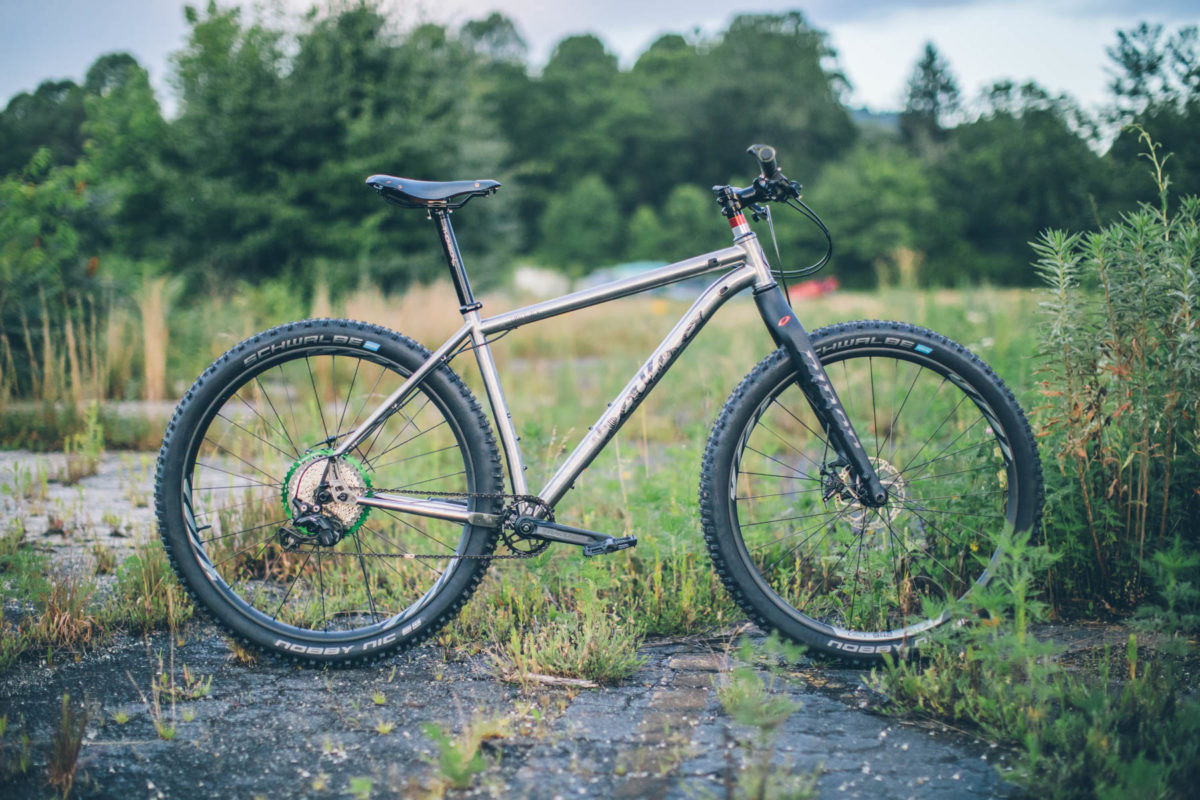
T’s Crossed
In addition to having a geometry that suits my tastes, the Salsa Timberjack checks a lot of other boxes. It has under downtube bottle mounts, internal cable routing, and Alternator 2 dropouts that make it possible to switch plates for various hubs and to run tire sizes from 27.5+ to 29 X 3.0*, including my new personal favorite, 29×2.6.
Could the Timberjack Ti be better?
Of course. No bike will ever be perfect, unless you have it built specifically for you… and you know exactly what it is that you want and need. I might have chosen a little more stack height and a slightly different tube arrangement—less standover and and maybe a little pot-belly bend in the downtube—to allow for a larger frame bag.
*Note that Salsa specifies that the Timberjack fits up to 29 X 2.6″ tires. Apparently, folks are cramming 29 X 3.0″ rubber on the aluminum versions, but they are very tight. I am speculating that the Timberjack Ti will fit 3.0s based on clearances depicted in the two photos directly above. These show a Nobby Nic 29 X 2.6 with the Alternator pretty far forward (maybe 1/4 the way back). I am guessing that it would fit a 29 X 2.8 comfortably with the Alternator slid all the way back, and even a 29 X 3.0, but it would probably be extremely tight. This is all speculation as I don’t currently have access to the bike to try. A friend of mine has the 2.6 Maxxis Rekon (which is close to true 2.6″) on his with the Alternator about 3/4 of the way back. It looks perfectly spaced with breathing room…
A Sum of its Parts
This build is made up of many carefully chosen components and several I ported over from other bikes. The Thomson stem and seatpost, Salsa Bend 2 handlebars, Ergon GS1 grips, Selle Anatomica X1 saddle, and TRP Spyke mech brakes were all recycled. The others were all picked by hand.
- Frame: Salsa Cycles Timberjack Ti (lg) w/ 148x12mm rear dropout
- Fork: Niner RDO Carbon MTB (110x15mm thru-axle)
- Headset: Cane Creek 110
- Handlebar: Salsa Bend 2 Bars
- Stem: Thomson Elite X4 (60mm)
- Seatpost: Thomson Elite
- Saddle: Selle Anatomica X1
- Grips: Ergon GS1
- Brakes: TRP Spyke Mechanical Disc (180mm rotors)
- Brake Levers: Avid Speed Dial Black Ops
Drivetrain
Eagle GX wasn’t yet on the market when I was speccing the drivetrain. Had it been available, the choice may have proven a little more difficult. That said, I’m perfectly content with this setup as I like the feel of Shimano XT shifting. I did make a few mods to personalize the gear range. First off, I added the 49T GC Cog and WolfCage Kit to the 11-42 XT CS-M8000 cassette. This replaced the 17T and 19T cogs with the 18T and 49T. I have nothing but good thing to say about this solution so far. Plus, my favorite crankset, the Race Face Aeffect, got a Wolf Tooth CAMO chainring system with an oval 30t ring. All of these tweaks bring the range to 445% with a granny gear of about 17.2 gear inches, perfect for loaded mountain biking.
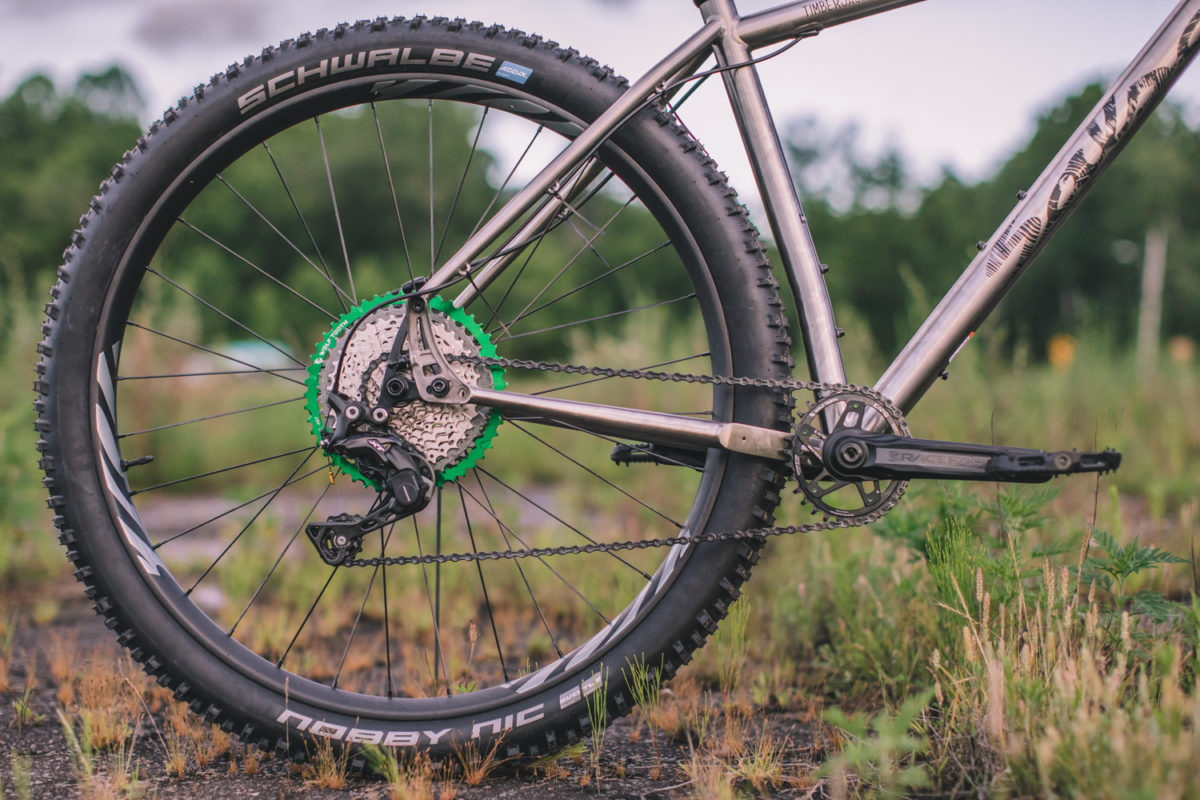
- Bottom Bracket: Hope Hope 68/73mm Stainless Steel
- Crank: Race Face Aeffect 175mm
- Chainring: CAMO with Wolf Tooth Narrow-Wide Elliptical (30t)
- Chain: Shimano
- Cassette: Shimano M8000 11spd 11-42 with 18/49t WolfCage Kit
- Shifter: Shimano XT
- Rear Derailleur: Shimano XT
Wheels
After demoing the Salsa Deadwood SUS, I was sold on the ‘Wide Trail’ concept. A 2.6” tire offers a stiffer sidewall while retaining many of the characteristics of plus tires, like increased floatation and traction. Additionally, it provides a little more cushion when set up tubeless. Gin and I both took the Schwalbe Nobby Nics and we have mostly positive things to say about the Nobby Nics and 2.6” tires in general.
The wheelset is my favorite part about this build. Laced up with steel spokes, the USA-built Ibis 942 includes a quick engagement I9 Torch hub and an asymmetric, low-profile rim design with a hookless bead. According to Ibis, this all nets a stronger wheel. The asymmetric design allows for higher spoke tensions and the rim design provides better impact strength. What ultimately drew me to these wheels was Ibis’ commitment to wide rims. The 35mm internal width makes the perfect pairing with 2.6-2.8” tires.
- Rims: Ibis 942 Carbon Wheels
- Hubs: Industry Nine Torch Classic
- Tires: Schwalbe Nobby Nic 29×2.6 Addix
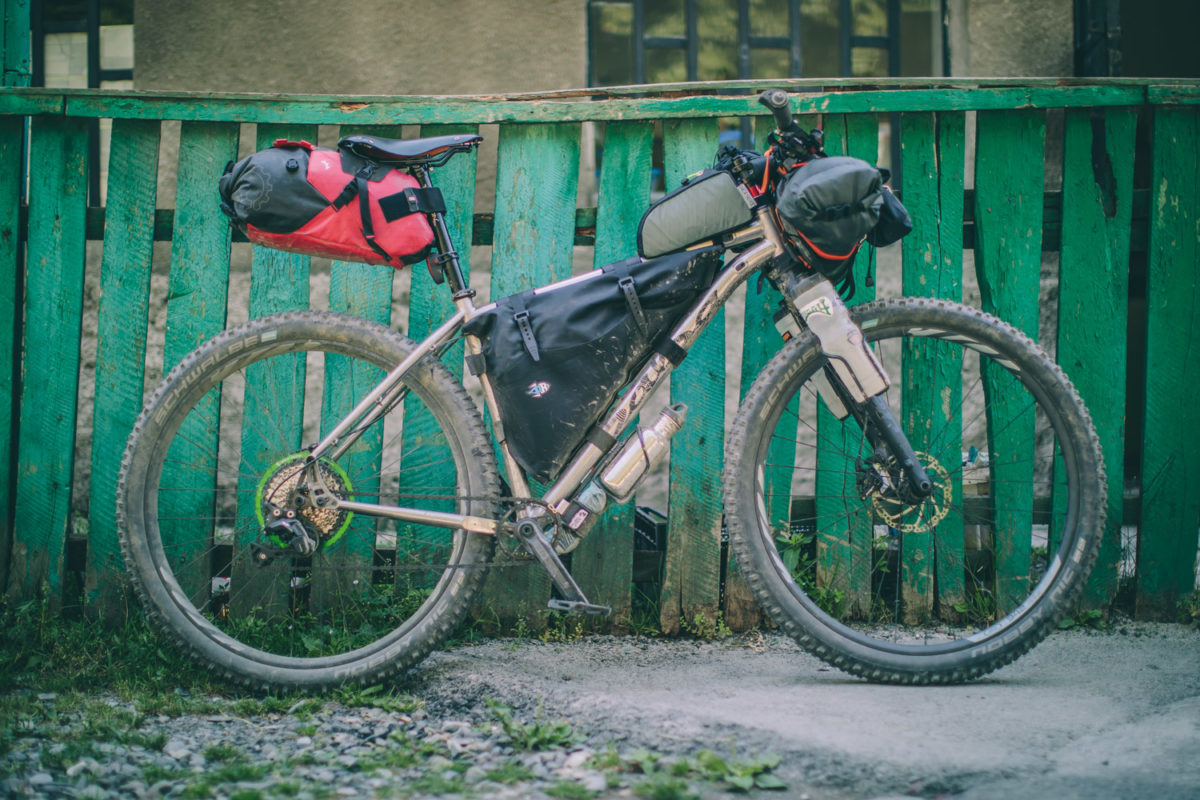
Bikepacking Bags & PACKLIST
Here is my full packing list, by bag:
Handlebars (Ortlieb Handlebar-Pack)
Sleep system (Big Agnes Fly Creek UL3 tent, Enlightened Equipment Revelation Quilt, Sea to Summit Ultralight Insulated Sleeping Mat, Big Agnes inflatable pillow)
Handlebars (Ortlieb Handlebar-Accessory)
Phone, hat, documents, sketch pad, pen and pencils, snacks
Handlebars (Revelate Mountain Feed Bag)
Spare camera lens
Top Tube (Oveja Negra Snack Pack XL)
Head lamp, cord, pocket knife, snacks, sunscreen
DOWNTUBE (Wolf Tooth B-RAD 3 with accessory strap)
Spare tube, water bottle
Frame bag (Porcelain Rocket 52Hz)
This is where I like to keep heavier items: Food, toolkit (tool roll with spares and all tools), 8 oz Orange Seal sealant, chain lube, rain jacket, Gore-Tex pants, Gore-tex socks
Seat Pack (Revelate Terrapin)
Clothes: 1 short sleeve merino t-shirt (Specialized), 1 long-sleeve Icebreaker wool skirt, Patagonia Merino Air bottoms, Patagonia travel pants, 2 pairs of wool socks, 1 pairs of underwear, toiletries
BACKPACK (Acre Hauser 14L)
Crumpler camera insert, Peak Design Capture Pro 2, Canon 5d, 2 lenses, Platypus 3L foldable water bladder, Sawyer squeeze bag (large), Montbell Down anorak
Into the mountains.
In my typical fashion, I put a lot of thought (maybe too much) into configuring this bike and really didn’t get to spend much time riding it before boxing it up for the Republic of Georgia. So, after all the thought and deliberation, is the bike everything I wanted and more? And most importantly, how did it actually ride?
During our abbreviated trip in the Caucasus Mountains, I found that the Timberjack Ti—and the parts and bits involved in this build—performed exactly how I expected. The bike is stiff, responsive, and insanely lightweight, which helped considerably on long climbs and during a couple epic hike-a-bikes in Tusheti National Park. It felt confident on technical, loaded descents. I’m also convinced that it fits me better than any bike I’ve ridden to date. As a tall rider, I’m sold on the idea of a “trail-touring” geometry that places importance on a steep seat tube and long top tube for balance and knee comfort.
Space metal is pretty great, too. Don’t get me wrong, simple and affordable steel bikes have served me well. But as I work my way through my 40s, the idea of a super lightweight bike that’s still hard wearing and resilient was increasingly getting under my skin. It’s an investment, but it promises a long life, even when subjected to the wear, tear, and general beating that can be attributed to long bikepacking trips. Unfortunately, during our first attempt at crossing Georgia by bike, my body wasn’t so indestructible… and our trip was cut short. But my Timberjack is still intact (hopefully) and waiting for me in someone’s garage in Tbilisi right now. I’m eagerly anticipating getting her back, and soon!
Please keep the conversation civil, constructive, and inclusive, or your comment will be removed.






